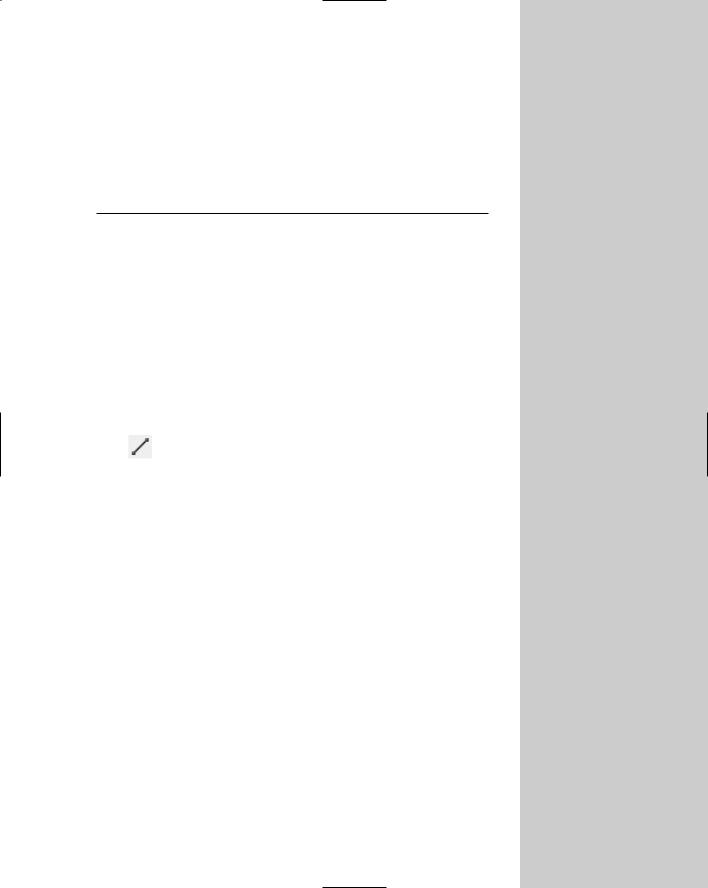
- •Foreword
- •Preface
- •Is This Book for You?
- •How This Book Is Organized
- •How to Use This Book
- •Doing the Exercises
- •Conventions Used in This Book
- •What the Icons Mean
- •About the CD-ROM
- •Other Information
- •Contacting the Author
- •Acknowledgments
- •Contents at a Glance
- •Contents
- •Getting Acquainted with AutoCAD and AutoCAD LT
- •Starting AutoCAD and AutoCAD LT
- •Creating a New Drawing
- •Using the AutoCAD and AutoCAD LT Interface
- •Creating Your First Drawing
- •Saving a Drawing
- •Summary
- •Creating a New Drawing from a Template
- •Working with Templates
- •Opening a Drawing with Default Settings
- •Opening an Existing Drawing
- •Using an Existing Drawing as a Prototype
- •Saving a Drawing Under a New Name
- •Summary
- •The Command Line
- •Command Techniques
- •Of Mice and Pucks
- •Getting Help
- •Summary
- •Typing Coordinates
- •Displaying Coordinates
- •Picking Coordinates on the Screen
- •Locating Points
- •Summary
- •Unit Types
- •Drawing Limits
- •Understanding Scales
- •Inserting a Title Block
- •Common Setup Options
- •The MVSETUP Command
- •Summary
- •Using the LINE Command
- •Drawing Rectangles
- •Drawing Polygons
- •Creating Construction Lines
- •Creating Rays
- •Summary
- •Drawing Circles
- •Drawing Arcs
- •Creating Ellipses and Elliptical Arcs
- •Making Donuts
- •Placing Points
- •Summary
- •Panning
- •The ZOOM Command
- •Aerial View
- •Named Views
- •Tiled Viewports
- •Snap Rotation
- •User Coordinate Systems
- •Isometric Drawing
- •Summary
- •Editing a Drawing
- •Selecting Objects
- •Summary
- •Copying and Moving Objects
- •Using Construction Commands
- •Creating a Revision Cloud
- •Hiding Objects with a Wipeout
- •Double-Clicking to Edit Objects
- •Grips
- •Editing with the Properties Palette
- •Selection Filters
- •Groups
- •Summary
- •Working with Layers
- •Changing Object Color, Linetype, and Lineweight
- •Working with Linetype Scales
- •Importing Layers and Linetypes from Other Drawings
- •Matching Properties
- •Summary
- •Drawing-Level Information
- •Object-Level Information
- •Measurement Commands
- •AutoCAD’s Calculator
- •Summary
- •Creating Single-Line Text
- •Understanding Text Styles
- •Creating Multiline Text
- •Creating Tables
- •Inserting Fields
- •Managing Text
- •Finding Text in Your Drawing
- •Checking Your Spelling
- •Summary
- •Working with Dimensions
- •Drawing Linear Dimensions
- •Drawing Aligned Dimensions
- •Creating Baseline and Continued Dimensions
- •Dimensioning Arcs and Circles
- •Dimensioning Angles
- •Creating Ordinate Dimensions
- •Drawing Leaders
- •Using Quick Dimension
- •Editing Dimensions
- •Summary
- •Understanding Dimension Styles
- •Defining a New Dimension Style
- •Changing Dimension Styles
- •Creating Geometric Tolerances
- •Summary
- •Creating and Editing Polylines
- •Drawing and Editing Splines
- •Creating Regions
- •Creating Boundaries
- •Creating Hatches
- •Creating and Editing Multilines
- •Creating Dlines
- •Using the SKETCH Command
- •Digitizing Drawings with the TABLET Command
- •Summary
- •Preparing a Drawing for Plotting or Printing
- •Creating a Layout in Paper Space
- •Working with Plot Styles
- •Plotting a Drawing
- •Summary
- •Combining Objects into Blocks
- •Inserting Blocks and Files into Drawings
- •Managing Blocks
- •Using Windows Features
- •Working with Attributes
- •Summary
- •Understanding External References
- •Editing an Xref within Your Drawing
- •Controlling Xref Display
- •Managing Xrefs
- •Summary
- •Preparing for Database Connectivity
- •Connecting to Your Database
- •Linking Data to Drawing Objects
- •Creating Labels
- •Querying with the Query Editor
- •Working with Query Files
- •Summary
- •Working with 3D Coordinates
- •Using Elevation and Thickness
- •Working with the User Coordinate System
- •Summary
- •Working with the Standard Viewpoints
- •Using DDVPOINT
- •Working with the Tripod and Compass
- •Getting a Quick Plan View
- •Shading Your Drawing
- •Using 3D Orbit
- •Using Tiled Viewports
- •Defining a Perspective View
- •Laying Out 3D Drawings
- •Summary
- •Drawing Surfaces with 3DFACE
- •Drawing Surfaces with PFACE
- •Creating Polygon Meshes with 3DMESH
- •Drawing Standard 3D Shapes
- •Drawing a Revolved Surface
- •Drawing an Extruded Surface
- •Drawing Ruled Surfaces
- •Drawing Edge Surfaces
- •Summary
- •Drawing Standard Shapes
- •Creating Extruded Solids
- •Drawing Revolved Solids
- •Creating Complex Solids
- •Sectioning and Slicing Solids
- •Using Editing Commands in 3D
- •Editing Solids
- •Listing Solid Properties
- •Summary
- •Understanding Rendering
- •Creating Lights
- •Creating Scenes
- •Working with Materials
- •Using Backgrounds
- •Doing the Final Render
- •Summary
- •Accessing Drawing Components with the DesignCenter
- •Accessing Drawing Content with Tool Palettes
- •Setting Standards for Drawings
- •Organizing Your Drawings
- •Working with Sheet Sets
- •Maintaining Security
- •Keeping Track of Referenced Files
- •Handling Errors and Crashes
- •Managing Drawings from Prior Releases
- •Summary
- •Importing and Exporting Other File Formats
- •Working with Raster Images
- •Pasting, Linking, and Embedding Objects
- •Summary
- •Sending Drawings
- •Opening Drawings from the Web
- •Creating Object Hyperlinks
- •Publishing Drawings
- •Summary
- •Working with Customizable Files
- •Creating Keyboard Shortcuts for Commands
- •Customizing Toolbars
- •Customizing Tool Palettes
- •Summary
- •Creating Macros with Script Files
- •Creating Slide Shows
- •Creating Slide Libraries
- •Summary
- •Creating Linetypes
- •Creating Hatch Patterns
- •Summary
- •Creating Shapes
- •Creating Fonts
- •Summary
- •Working with Menu Files
- •Customizing a Menu
- •Summary
- •Introducing Visual LISP
- •Getting Help in Visual LISP
- •Working with AutoLISP Expressions
- •Using AutoLISP on the Command Line
- •Creating AutoLISP Files
- •Summary
- •Creating Variables
- •Working with AutoCAD Commands
- •Working with Lists
- •Setting Conditions
- •Managing Drawing Objects
- •Getting Input from the User
- •Putting on the Finishing Touches
- •Summary
- •Understanding Local and Global Variables
- •Working with Visual LISP ActiveX Functions
- •Debugging Code
- •Summary
- •Starting to Work with VBA
- •Writing VBA Code
- •Getting User Input
- •Creating Dialog Boxes
- •Modifying Objects
- •Debugging and Trapping Errors
- •Moving to Advanced Programming
- •A Final Word
- •Installing AutoCAD and AutoCAD LT
- •Configuring AutoCAD
- •Starting AutoCAD Your Way
- •Configuring a Plotter
- •System Requirements
- •Using the CD with Microsoft Windows
- •What’s on the CD
- •Troubleshooting
- •Index

94 |
Part I AutoCAD and AutoCAD LT Basics |
Finally, AutoCAD prompts you to set the drawing limits with the following two prompts:
Enter the paper width:
Enter the paper height:
After each prompt, enter a number based on the size of the paper you plan to plot on. AutoCAD draws a rectangle of the size you indicated for the drawing limits.
Using the Setup Wizards
There are two wizards to help you set up a drawing. You need to activate the Startup dialog box to find them:
1.Choose Tools Options and click the System tab. In the General Options section, choose Show Startup Dialog Box from the Startup drop-down list. Click OK.
2.Choose File New. You see the Startup dialog box.
3.Click the Use a Wizard button. Choose Quick Setup for fewer options or Advanced Setup for more options.
4.Click OK and follow the prompts of the wizard.
Summary
This chapter explained setting up a drawing so that it behaves the way you want it to. You read about:
Setting the unit type
Setting the angle type, measure, and direction
Drawing limits
Using scales and calculating a scale factor
Setting drawing aids and creating a template that includes the settings that you want
Using MVSETUP (AutoCAD only) or the setup wizards to set up your drawing
This chapter ends Part I, “AutoCAD Basics.” Now that you know the basics, you can go on to Part II, “Drawing in Two Dimensions.” The next chapter covers drawing simple lines, polygons, rectangles, and infinite construction lines.
|
|
|

Drawing in Two
Dimensions
Now that you have the basics under your belt, it’s time to draw! In Part II, you learn the techniques for basic drawing and edit-
ing in AutoCAD and AutoCAD LT. After chapters on drawing simple lines and curves, I explain how to control the display of your drawings. You can also find chapters on creating text, drawing dimensions, and creating dimension styles. Separate chapters cover getting information from your drawing and drawing complex objects. Part II winds down with a chapter on plotting and printing. This part contains all the basic information you need for two-dimensional drawing and design.
P A R T
II
In This Part
Chapter 6
Drawing Simple Lines
Chapter 7
Drawing Curves and Points
Chapter 8
Viewing Your Drawing
Chapter 9
Editing Your Drawing:
Basic Tools
Chapter 10
Editing Your Drawing:
Advanced Tools
Chapter 11
Organizing Drawings with Layers, Colors, Linetypes, and Lineweights
Chapter 12
Getting Information from Your Drawing
Chapter 13
Creating Text
Chapter 14
Drawing Dimensions
Chapter 15
Creating Dimension Styles
and Tolerances
Chapter 16
Drawing Complex Objects
Chapter 17
Plotting and Printing Your
Drawing


Drawing
Simple Lines
Lines are the most commonly drawn object — you’ll use the LINE command a lot! Related commands for drawing rectangles, polygons, and construction lines are also important, so you should have
all these commands in your arsenal. This chapter explains how to draw all these types of objects.
Using the LINE Command
Part I included several exercises in which you drew lines. However, the LINE command has several options, and you can still learn a few tricks of the trade by focusing on the LINE command itself.
To draw a line, choose Line from the Draw toolbar. At the Specify first point: prompt, specify any point. Continue
to specify points until you’re finished. Press Enter to end the command. You can also right-click and choose Enter from the shortcut menu. The LINE command assumes you will continue to use it over and over. For this reason, the command continues to prompt you until you press Enter.
If you continue to draw line segments, the subsequent prompts are different. Here’s how to use them:
The command displays the Specify next point or [Undo]:
prompt for the next two segments. Right-click and choose Undo (or type u ) to undo only the last line segment you created — without exiting the LINE command.
After creating at least two line segments, the command displays
the Specify next point or [Close/Undo]: prompt. Rightclick and choose Close (or type c ) to automatically draw a line from the endpoint of the last segment to the original start point, thereby creating a closed figure. You can continue to use the Undo option as well.
If you previously drew a line, press Enter at the Specify first point: prompt to start the line at the endpoint of the last line. If you most recently drew an arc, press Enter to start the line at the endpoint of the arc and draw it tangent to the arc.
C 6H A P T E R
In This Chapter
Using the LINE command
Drawing rectangles
Drawing polygons
Creating construction lines
Creating rays
